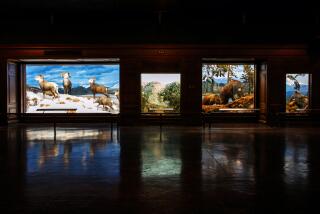Buffalo Museum Putting Final Touches on Unusual Exhibit on Endangered Species
- Share via
BUFFALO, N.Y. — The Hall of Endangered Species--perhaps the first museum exhibit of its kind in the country--is taking shape at the Buffalo Museum of Science.
Tucked away in a second-floor side room of the spacious facility, curator Arthur Clark and just about every person on the museum’s 55-member staff are putting the finishing touches on the exhibition, which will open May 29. The exhibit was Clark’s brainchild.
“Since the year 1600 we have gotten a good picture of the rate of extinction,” said Clark, associate curator of vertebrate zoology and the museum’s associate director. “It is increasing considerably and it’s all due to humans.”
The hall, designed by John Formella and Conrad Cain of the museum’s exhibits staff, provides a thought-provoking walk-through look at the whys and hows of extinction.
Six Basic Themes
The exhibit deals with six basic themes--the problem of the increasing rate of extermination, direct and indirect ways in which man exterminates wildlife, why we exterminate wildlife, why we should save wildlife and how we can save it.
While walking through an area of the hall that features endangered forms of water life, such as whales, sea turtles and lake sturgeon, Clark pointed out that the estimated 4 million whales in the world at the turn of the century have dwindled to an estimated 2 million.
“The sea turtle is endangered,” Clark said, “but man still harvests about 100 tons a year.”
The fur trade area of the hall features a life-sized model of a hunter standing over a slain Indian tiger. In reality, the tiger had died of natural causes at the Buffalo Zoo and was mounted by museum taxidermist James Dorr.
“There are a number of hunters in Asia and India that have shot over 300 tigers each,” Clark said. “After you do all the research on this, you start wondering if there’s any hope.”
Rhinoceros Model
Perhaps the most stark exhibit in the hall is a diorama of an African savanna that houses a life-size model of a black rhinoceros. The 10-foot long rhino was built by Louis Paul Jones Inc. of Hudson, N.Y., and is sturdy enough for children to sit on to have their picture taken.
Clark said rhino horns are used for fever-reducing medicines in the Orient, and dagger handles made from the horns are a status symbol in North Yemen.
There were about 90,000 black rhinos in 1970, Clark said, but they dwindled to an estimated 8,000 in 1984 and to less than 4,500 last year. The horns sell for about $300 a pound.
“The loss of rhinos has been drastic, especially black rhinos,” Clark said.
The exhibit also brings into question man’s destruction of woodlands.
“We bulldoze land with seemingly little concern with what’s going to happen tomorrow,” Clark said. “Once you destory the place where the animal lives, eats and raises its young, you have all but destroyed the animal.”
Ecological Pyramid
Near the hall’s exit is a block-by-block ecological pyramid that man is connected to, along with all the various animal species.
“As you take the blocks out of this pyramid, as animals become extinct, at what point do you pull out the block that upsets the balance?” Clark asked.
As you exit the hall, a mirror has a simple, blunt question printed above it: “Another endangered species?”
“This should get you thinking as to what we can do to save the animals,” Clark said. “What we’ve got to do is dry up the market and demand.”
Clark first proposed the Hall of Endangered Species, which has cost an estimated $100,000 to construct, in 1972, but “the powers that be thought it was too controversial,” he said.
Time, and the problem, caught up with Clark’s idea.
“We’re already turning a few heads,” Clark said. “ . . . I called a number of museums to see any similar exhibits, but I couldn’t find one.”
More to Read
The biggest entertainment stories
Get our big stories about Hollywood, film, television, music, arts, culture and more right in your inbox as soon as they publish.
You may occasionally receive promotional content from the Los Angeles Times.









